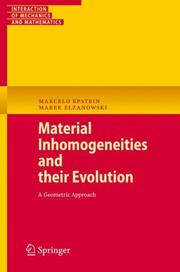| Listing 1 - 3 of 3 |
Sort by
|
Book
Year: 1982 Publisher: Warszawa Wydawnictwa uniwersytetu Warszawskiego
Abstract | Keywords | Export | Availability | Bookmark
 Loading...
Loading...Choose an application
- Reference Manager
- EndNote
- RefWorks (Direct export to RefWorks)

ISBN: 9783540723721 3540723722 9786611044121 1281044121 3540723730 Year: 2007 Publisher: Berlin : Springer,
Abstract | Keywords | Export | Availability | Bookmark
 Loading...
Loading...Choose an application
- Reference Manager
- EndNote
- RefWorks (Direct export to RefWorks)
Inhomogeneity theory is of importance for the description of a variety of material phenomena, including continuous distributions of dislocations, fracture mechanics, plasticity, biological remodelling and growth and, more generally, all processes that entail changes in the material body driven by forces known in literature as material or configurational. This monograph presents a unified treatment of the theory using some of the tools of modern differential geometry. The first part of the book deals with the geometrical description of uniform bodies and their homogeneity (i.e., integrability) conditions. In the second part, a theory of material evolution is developed and its relevance in various applied contexts discussed. The necessary geometrical notions are introduced as needed in the first two parts but often without due attention to an uncompromising mathematical rigour. This task is left for the third part of the book, which is a highly technical compendium of those concepts of modern differential geometry that are invoked in the first two parts (differentiable manifolds, Lie groups, jets, principal fibre bundles, G-structures, connections, frame bundles, integrable prolongations, groupoids, etc.). To make the text as useful as possible to active researchers and graduate students, considerable attention has been devoted to non-standard topics, such as second-grade materials, Cosserat media and functionally graded bodies.
Inhomogeneous materials --- Geometry, Differential. --- Géométrie différentielle --- Mathematical models. --- Inhomogeneous materials -- Mathematical models. --- Inhomogeneous materials. --- Geometry, Differential --- Physics --- Chemical & Materials Engineering --- Engineering & Applied Sciences --- Physical Sciences & Mathematics --- Atomic Physics --- Materials Science --- Applied Mathematics --- Mathematical models --- Differential geometry --- Heterogeneous materials --- Inhomogeneous media --- Media, Inhomogeneous --- Engineering. --- Applied mathematics. --- Engineering mathematics. --- Mechanics. --- Continuum mechanics. --- Continuum Mechanics and Mechanics of Materials. --- Appl.Mathematics/Computational Methods of Engineering. --- Applications of Mathematics. --- Mechanics of continua --- Elasticity --- Mechanics, Analytic --- Field theory (Physics) --- Classical mechanics --- Newtonian mechanics --- Dynamics --- Quantum theory --- Engineering --- Engineering analysis --- Mathematical analysis --- Construction --- Industrial arts --- Technology --- Mathematics --- Materials --- Matter --- Mechanics, Applied. --- Mathematics. --- Solid Mechanics. --- Mathematical and Computational Engineering. --- Classical Mechanics. --- Math --- Science --- Applied mechanics --- Engineering, Mechanical --- Engineering mathematics
Book
ISBN: 9783540723738 Year: 2007 Publisher: Berlin Heidelberg Springer Berlin Heidelberg
Abstract | Keywords | Export | Availability | Bookmark
 Loading...
Loading...Choose an application
- Reference Manager
- EndNote
- RefWorks (Direct export to RefWorks)
Inhomogeneity theory is of importance for the description of a variety of material phenomena, including continuous distributions of dislocations, fracture mechanics, plasticity, biological remodelling and growth and, more generally, all processes that entail changes in the material body driven by forces known in literature as material or configurational. This monograph presents a unified treatment of the theory using some of the tools of modern differential geometry. The first part of the book deals with the geometrical description of uniform bodies and their homogeneity (i.e., integrability) conditions. In the second part, a theory of material evolution is developed and its relevance in various applied contexts discussed. The necessary geometrical notions are introduced as needed in the first two parts but often without due attention to an uncompromising mathematical rigour. This task is left for the third part of the book, which is a highly technical compendium of those concepts of modern differential geometry that are invoked in the first two parts (differentiable manifolds, Lie groups, jets, principal fibre bundles, G-structures, connections, frame bundles, integrable prolongations, groupoids, etc.). To make the text as useful as possible to active researchers and graduate students, considerable attention has been devoted to non-standard topics, such as second-grade materials, Cosserat media and functionally graded bodies.
Mathematics --- Classical mechanics. Field theory --- Fluid mechanics --- Engineering sciences. Technology --- analyse (wiskunde) --- toegepaste wiskunde --- ingenieurswetenschappen --- mechanica
| Listing 1 - 3 of 3 |
Sort by
|

 Search
Search Feedback
Feedback About UniCat
About UniCat  Help
Help News
News